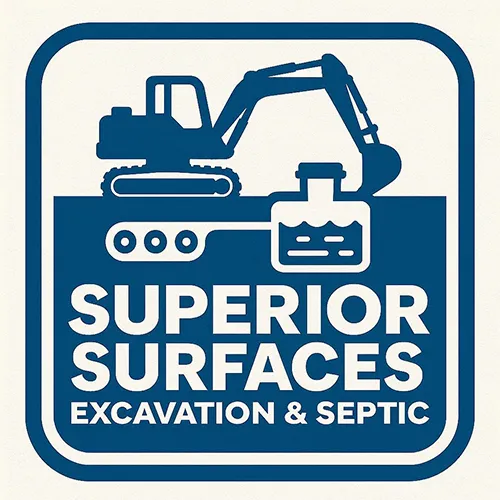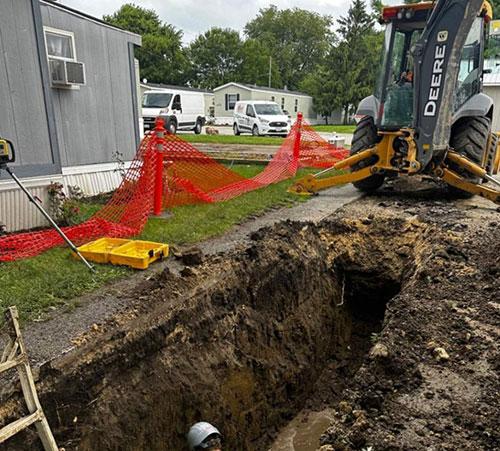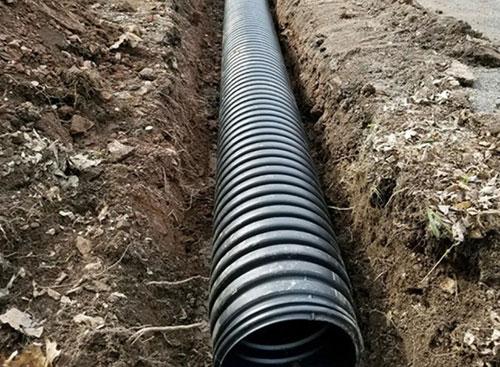
Serving Michigan counties: Macomb, St Clair, Wayne, Oakland, Genesee, and Tuscola Counties
Drainage Systems near Macomb County, Michigan
Superior Surfaces LLC is Committed to superior quality and results!

AVOID COSTLY MISTAKES:
Do NOT hire an excavating contractor without first reading our free guide:
The ULTIMATE Excavation & Septic "Success Guide."

Drainage Systems near Macomb County: clear water, solid ground
Water should move away from your home, not toward it. If you deal with puddles that linger, a mushy lawn, or basement moisture after every storm, you’re not alone. Across Macomb County, Michigan, clay-heavy soils and freeze–thaw cycles push water to sit where it doesn’t belong. Well-planned drainage collects, redirects, and releases water safely so your yard, driveway, and foundation stay dry and stable year-round.
How Can We Help?


What “drainage Systems near Macomb County” actually do
A modern drainage system is a network that manages surface and subsurface water. It starts with observation—where water comes from, where it flows, and where it should go. Then it uses the right tools: French drains, curtain drains, catch basins, channel drains, swales, regrading, downspout extensions, dry wells, and sump discharge lines. In Macomb County neighborhoods—from Sterling Heights to Shelby Township—these pieces work together to keep water off structures, protect soils, and reduce freeze-related heave.
Benefits of Drainage Systems near Macomb County
Effective drainage delivers practical wins you can feel every season:
Protects foundations by relieving hydrostatic pressure and keeping water away from footings.
Keeps basements and crawlspaces drier, reducing mold risk and that musty smell.
Stabilizes patios, driveways, and walkways by preventing erosion and frost heave.
Preserves landscaping and grass by avoiding root rot and muddy ruts.
Improves usability—yards dry out faster, so you can get outside sooner after rain or snowmelt.
Boosts property value and curb appeal with a cleaner, safer site.
Benefits of hiring a drainage system near Macomb County specialist
Designing drainage is more than digging a trench. A local specialist understands Macomb County storm patterns, clay and loam soil behavior, and municipal expectations in Michigan. They survey elevations, run laser levels, and calculate slopes so water actually moves. They choose the correct pipe type and fabric, set cleanouts, and size outlets to avoid backups. They also protect utilities, pull permits when needed, and restore lawns and hardscapes when the work is done.
Common solutions, explained in plain language
French drains. A perforated pipe wrapped in fabric and surrounded by clean stone. It captures subsurface water and carries it to a safe outlet.
Curtain drains. Similar to a French drain but shallow and upslope, intercepting water before it reaches your home or drive.
Channel drains. Linear grates set in concrete across garages or patios to catch surface flow.
Catch basins. Boxes that collect runoff at low points and link to a solid pipe.
Downspout extensions. Bury and route roof water far from the foundation to a pop-up emitter or daylight.
Swales and regrading. Shape the ground so gravity does the work, guiding water along a gentle path.
Dry wells. Underground chambers or stone pits that disperse water into the soil over time.
Sump discharge lines. Solid, sloped piping that carries pumped water to a legal, non-erosive outlet.
See Our Excavation and Septic

✔️ Commercial Excavation
✔️ Residential Excavation
✔️ Basement Excavation
✔️ Demolition
✔️ Large Pond Construction
✔️ Small Pond Construction
✔️ Dozer Work
✔️ Forestry Mulching
✔️ Grading, Lot Clearing
✔️ Retaining Walls
✔️ Concrete Flatwork - Driveways, Sidewalk, Foundations
✔️ Foundation Repairs
✔️ Full Site Preparation
✔️ Foundation Repairs
Quality Services Launched FAST!

✔️Septic Install and Repair
✔️ Septic Inspections
✔️ Septic Installs Traditional Systems
✔️ Septic Tanks - Plastic/Poly
✔️ Septic Tanks - Concrete
✔️ Drain Field Replacement
✔️ Drainage Systems
✔️ Aerobic Treatment Systems
✔️ French Drains
✔️ Trenching
What Are You Waiting For?
The process for hiring a drainage system near Macomb County pro
1) Discovery and goals. Share the symptoms—wet lawn areas, pooling after storms, icy spots, or interior dampness. Note seasons when it’s worst.
2) Site evaluation. The pro walks the property, marks utilities, shoots grades, notes soils, and maps inlets and outlets.
3) Design and proposal. You’ll receive a plan that shows locations, depths, slopes, materials, and the discharge point, plus a clear price and timeline.
4) Permits and prep. If permits or soil erosion controls are required in your part of Michigan, they’re handled before work begins.
5) Installation. Trenches are cut, fabric and stone placed, pipes set to grade, and outlets finished with popups, riprap, or daylight.
6) Testing and cleanup. Systems are flushed and checked for positive flow. Lawns are raked smooth; hardscapes are cleaned.
7) Maintenance plan. Simple routines—keep grates clear, verify outlets, and schedule periodic inspections—help your system last.
How do we choose the right system for your property?
Every yard has its own water story. A good designer starts with the source: roof area, uphill neighbors, sprinklers, and natural springs. Then they look at where water currently sits—low corners, fence lines, window wells, or behind retaining walls. Finally, they select the safest release point: a storm connection (where allowed), daylight on a slope, or a carefully sized dry well. The design balances performance, code, budget, and future landscaping.
Materials and methods that matter
Quality materials reduce callbacks and keep your property tidy:
Washed stone that won’t clog with fines.
Non-woven geotextile fabric to separate soil and stone.
Cleanouts and inspection points for easy maintenance.
Proper backfill and compaction to avoid settling.
Seasonal realities in Macomb County, Michigan
Freeze–thaw is real here, and spring can be soggy. That means slopes must be accurate, outlets must stay above grade, and pipes should be deep enough to avoid crushing yet shallow enough to stay serviceable. Leaves in fall can block grates; snow piles can create meltwater channels. A plan that accounts for all four seasons performs better and lasts longer.
Ready to plan drainage systems near Macomb County?
A dry, usable property doesn’t happen by accident. It’s the result of thoughtful design and careful installation that respects local soils, grades, and Michigan’s seasons. If standing water, basement dampness, or erosion keep returning, it’s time to act. Start with a simple assessment, choose the right mix of solutions, and put gravity to work for you. Your yard—and your foundation—will thank you.
Quick homeowner checklist for drainage success
Walk the site during rain, photograph trouble spots, measure downspout flow, confirm legal discharge locations, and mark utilities before digging. When comparing proposals for drainage systems near Macomb County, ask about slopes, fabric type, stone gradation, pipe strength, and where maintenance access points will be located clearly.
Hours: Monday-Saturday 6:00am-6:00pm
Extended hours by appointment only.
Address: 23450 29 Mile Rd, Ray, MI 48096, USA
All rights reserved | Client Support Area